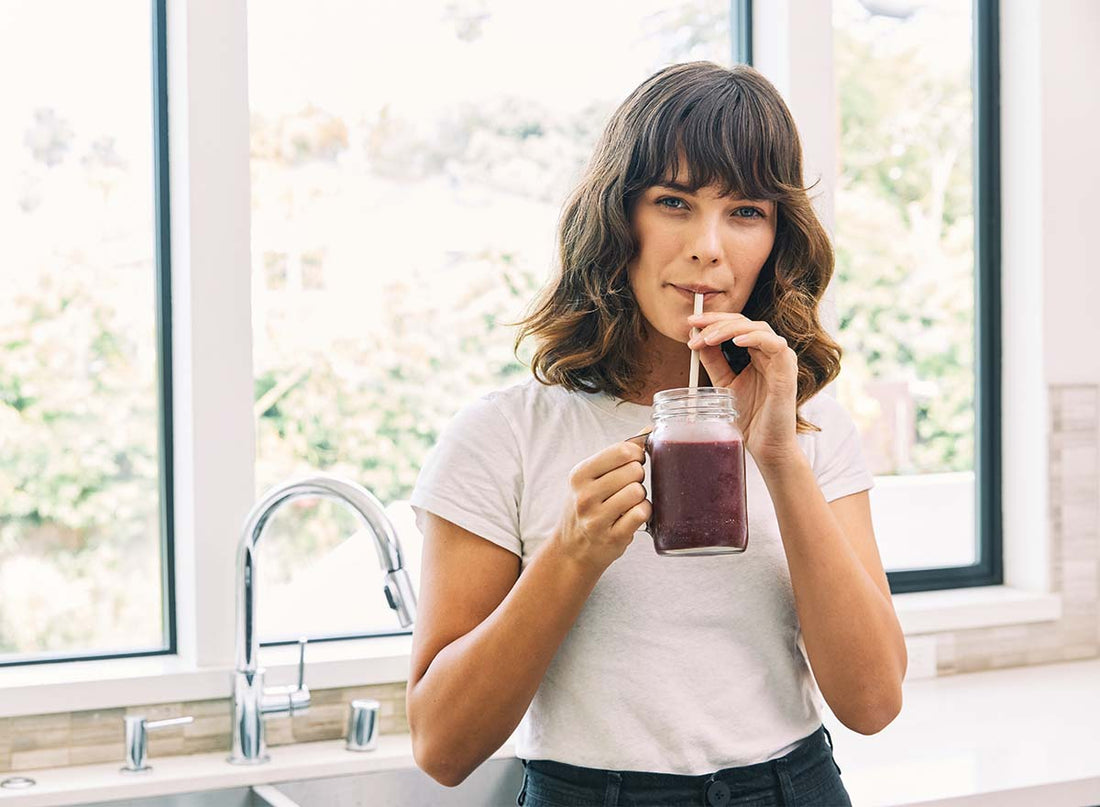If you're new to the meal prepping process, we’re here to help you learn how to properly store your favorite smoothie recipes to make your busy week just a bit easier. Plus, who wants to toss a perfectly good leftover smoothie into the trash?
In this article, we’ll teach you how to keep smoothies fresh and ready to grab and go in the refrigerator, the freezer, or your lunchbox to help you enjoy your tasty treats a few hours or days after you blend them up.
We’ll break down four tips for perfect smoothie storage— using the right containers for the job, keeping track of dates, and harnessing the power of ice packs. Just make sure to always mix your stored smoothies with a spoon before you start sipping, as ingredients tend to separate when stored. Whether you’re trying to learn how to store fruit smoothies in freezers or pack a smoothie for lunch, we’re here to help.
#1 Save Smoothies Without Leafy Greens and Dairy
One of the best parts of smoothie-making is exploring how different ingredients produce vibrant, appetizing colors. If you make fruit smoothies using frozen Açaí, for instance, you likely produce downright pretty, purple smoothies that tempt your palate and get your stomach grumbling.
That being said, we don’t recommend storing smoothies with dairy and leafy greens as most of these smoothies will turn brown in just a few hours.
This perfectly normal biological process is called enzymic browning, and there are a few key things to note about why your leafy green smoothies will turn brown with time:
- During enzymatic browning, some fruits and vegetables turn brown when exposed to air.
- The longer a fruit or vegetable is exposed to air, the more browning will occur.
- As a result of enzymatic browning, fruits and vegetables can lose some of their nutrient content.
So, you should consider storing homemade smoothies that don’t contain dairy, leafy greens or fruits that brown easily—apples, bananas, and pears—and opting to drink your delicious, nutritious, green and dairy smoothies immediately after blending.
#2 Use Appropriate Containers
Whether you’re storing smoothies for freezing, refrigeration, or lunchbox transport, you’ll need the best container for the job. Let’s explore which storage methods work best for each scenario:
- Freezing – If you plan to store your homemade smoothies in the freezer for a few days, and always store smoothies in a freezer that has a temperature below 20 degrees fahrenheit to help prevent microbial growth. You can use plastic and glass containers, but ensure you leave enough headspace for the smoothie to expand and always ensure your storage container has been cleaned with warm soapy water and sanitized before storing your smoothie in it.
Remember, always follow food safe guidelines when handling your ingredients, preparing and storing your smoothies. Wash and sanitize your hands, blender, cutting knives and containers before preparing your smoothies.
- Refrigeration – Since your frozen smoothie is unlikely to freeze if you’re simply sticking it in the refrigerator, you have a little more storage freedom. You can use plastic, glass, or silicone containers, but it’s critical that your container seals well to prevent evaporation—no one likes a dehydrated fruit juice smoothie.
- Lunchbox storage – If you want to drink a banana smoothie at lunch, prepare your smoothie in a portable drink container or tumbler in the morning, add it to your insulated lunch box and cover the smoothie with multiple ice packs as smoothies always need to be at a temperature of 40 degrees fahrenheit.
#3 Keep Track of Dates
While your smoothie may not turn brown during storage if it doesn’t contain leafy greens, oxidation—chemical changes upon exposure to oxygen—can still degrade the vitamins and minerals in the fruits and vegetables you blend into your smoothie.
Therefore, you’ll want to limit your storage timeframes. Try to only store refrigerated smoothies for up to 48 hours, lunchbox smoothies for up to 5 hours, and frozen smoothies for up to 7 days to ensure optimal nutrient absorption once you slurp down your blended treat.
Label your containers carefully to make sure you consume your healthy smoothies within ideal time limits.
#4 Use Ice Packs for Lunch Boxes
While, ideally, your insulated lunchbox will keep your smoothie cold enough until lunchtime, not all lunch boxes are created equal:
- Zip-up lunch boxes are usually economical and flexible enough to cram into an already-stuffed backpack or briefcase. However, air can sometimes leak through zipper enclosures.
- Hard-sided lunch boxes sometimes have more high-tech seals and gaskets to maintain internal temperature, but these seals aren’t always durable.
As we mentioned above, you should always add multiple ice packs around your portable drink container or tumbler in your lunchbox when transporting your blended beverages. Keeping your smoothie under 40 degrees farenheit will prevent oxidation and ensure that it stays appetizing while you count down the minutes until your lunch break.
SAMBAZON: Making Açaí Smoothies Simple Since 2000
When it comes to storing blended smoothies, being aware of your ingredients, using the right containers, keeping track of timelines, and using ice packs can all help keep your healthy smoothies fresh and packed with nutrients.
At SAMBAZON, we’re continuing to revolutionize Açaí production. When you add one of our frozen Açaí superfruit packs to your favorite frozen fruit smoothie recipe, you can rest easy knowing that your energy-packed, nutrient-rich meal is made with the best ingredients on the market today.
Whether you’re making a frozen fruit smoothie to slurp down right away or preparing your lunches for the week ahead, harness the power of Açaí with SAMBAZON.
Looking for more information on what Açaí bowls are made of? Be sure to check out our latest blog to learn all of the ins and outs of our favorite fruit!
Sources:
Institute of Food Science and Technology. Fruit and Vegetables: Enzymic Browning. https://www.ifst.org/lovefoodlovescience/resources/fruit-and-vegetables-enzymic-browning
Penn State. Water (Its Volume Expansion Upon Freezing). https://www.e-education.psu.edu/matse81/node/2119

